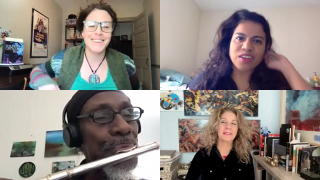Using Arts Advocacy
“Using Art as Advocacy” was a webinar hosted on February 17, 2022 by the UU@UN (Unitarian Universalist Association’s office at the United Nations). This event showed how art can be used to build community and inspire change in chaotic times. Art can result in profound social change when used as a tool for those who live or work outside of the political space. This webinar explored how art can be used for advocacy for various global issues such as climate justice, prison reform, civil rights, and gun control.
The first speaker on the panel moderated by UU@UN Director Bruce Knotts was Stacie Brennan from Lehigh University Art Galleries in Pennsylvania. Ms. Brennan spoke about the various exhibits and initiatives that she is responsible for as the Curator of Education. She emphasized that the galleries’ programming is not just lectures but also hands-on experiences, which are critical for learning. She discussed yoga classes, voter registration drives, and other activities to empower students. She showed photographs from ongoing exhibits, e.g. Young, Gifted, and Black, displaying performance arts from Black/Brown communities to showcase their struggles. Also on exhibit is Hear Me Roar, in honor of the 50th anniversary of the first class of undergraduate women at Lehigh University, highlighting ten women photographers and the resilience of women across generations.
The second panelist was Marissa Gutierrez-Vicario, the Founder and Executive Director of ARTE (Art and Resistance Through Education). ARTE was launched in 2013 to help young people amplify their voices and organize for human rights change in their communities through the visual arts. ARTE is also heavily involved in amplifying the voices of people who are jailed and in breaking the school-to-prison pipeline. She shared ARTE’s murals that confront issues of mass incarceration and police reform. Her presentation also included discussions and images of their other projects such as Women Breaking Barriers: Global Women Heroes.

ARTE murals "Global Women Heroes" and "Prison is a Feminist Issue"
The last set of speakers, and completing our panel, were from an organization called Artivism: The Power of Art for Social Transformation. Artivism was co-founded by Carolina Cambronero Varela and Argie Moutafis-Agelaris, M.A. (also known as Professor RG). Artivism is an ongoing multimodal collaboration sponsored by Sing for Hope, Adelphi University, and the Gottesman Libraries at Teachers College, Columbia University. Artivism showcased three of their artists’ projects during their presentation. First up was Karlee Rodrigues, M.A. (Film and Media Studies, Columbia University School of the Arts). Karlee discussed cultural representations in films, cultural inequalities in films, and how policies in filmmaking exacerbated discrimination and racism. She also read an original poem from one of her students, Rowan McKiernan, who was a student ambassador for Artivisim.
Artivism’s next guest, the RING Team (Reggio Inspired Network of Greece), highlighted the work of kindergarten students and what they learned about human rights and the freedom of artistic expression. Most notably, two of the three schoolteachers from Greece (Despina Sakoulogeora and Garyfalia Terizakis) of the RING Team shared their students’ interpretation of the famous sculpture the Knotted Gun. The 4-6 year old students composed a poem (YouTube) where they envisioned a world without violence, which was shared with our attendees.
Closing out Artivism’s portion of the webinar was a live musical performance by Dawud Rahman, a MOTI musician (Music on the Inside). He did a flute solo of The Jackson 5’s “I’ll Be There.” Dawud shared his interpretation of the first few lines of the song—“You and I must make a pact, we must bring salvation back”—the need for salvation or saving the world, as it may be destined for death due to ecological reasons. Dawud spent decades in prison and kept himself alive through music. He has been studying the flute and the saxophone under some jazz greats for the past year and a half.
The webinar challenged attendees with thought provoking questions: What are we learning? How do we access our human connections? What are we doing to transform and change this morbid society? The arts can be the answer to all of these concerns. The arts have such an important role in society, since they lead to opportunities for a dignified life, not just for the privileged few but for all people. Art is a human right.
View the event recording and read speakers' full bios at the Using Art as Advocacy event webpage.
